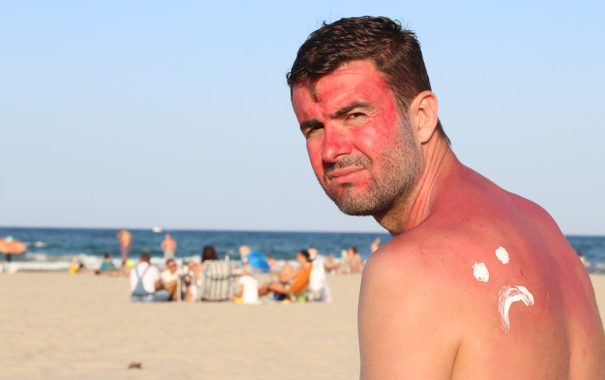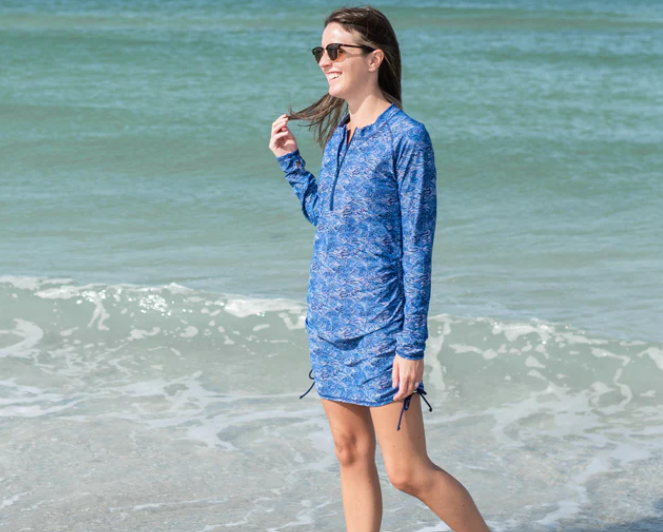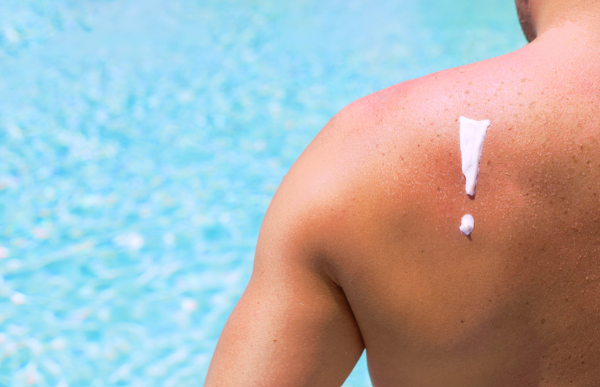
What to do for sun poisoning
Sun poisoning is serious. The World Health Organization cites 1.2 million cases of non-melanoma skin cancers and 325,000 melanomas yearly due to UV rays. Obviously, proper sun protection is the best strategy, but if you find yourself with sun poisoning, you need to know what to do for it.
Quick links:
How to treat sun poisoning at home?
Can you die from sun poisoning?
We'll show you how to treat sun poisoning, and when to seek medical attention.
What is sun poisoning?
Sun poisoning is a severe sunburn resulting from excessive exposure to ultraviolet (UV) radiation. Sun poisoning occurs when UV rays permeate through unprotected skin causing extensive surface inflammation and skin cell damage.
Unlike a mild pink sunburn, sun poisoning causes symptoms such as blistering, chills, nausea, and extreme fatigue, some of which can appear within 15 minutes of sun exposure. This happens because the body reacts to the sun's radiation, releasing inflammatory chemicals that make the whole body feel ill. Without proper treatment, sun poisoning can have serious effects.
How to treat sun poisoning at home?
You treat sun poisoning by focusing on soothing the symptoms. You should also limit sun exposure and monitor the skin closely for complications that require medical care.
- Aloe vera gel soothes the skin and helps it heal. Apply aloe gel to the affected areas to relieve the symptoms of sun poisoning.
- Cool the skin using lightweight clothing, compresses, cold baths, or soothing bandages.
- Drink plenty of water to aid in the body's recovery process.
- Protect the affected skin from additional sun exposure until it has fully healed. Stay indoors during peak sunlight hours or wear protective clothing and sunscreen if going outside.
- Take over-the-counter pain relievers like NSAIDs to help manage skin pain, chills, and headaches.
- Gently clean blistered skin and apply antibiotic creams to prevent potential skin infection.
- Rest, avoid physical strain, and eat nutrient-rich, light meals to support healing.
Carefully monitor for fever, low blood pressure, fainting, allergic reactions, and other severe symptoms that require emergency medical care. If symptoms don't vastly improve within 1-2 days, go to your doctor.
What to do if you need medical attention
For severe sun poisoning cases, go to the nearest hospital emergency room or urgent care clinic to get medical attention. They are likely to treat you with one or more of the following interventions:
- IV fluid rehydration therapy: one key treatment is intravenous fluids which directly restore fluid balance from vomiting, sweating, and cellular damage. This is crucial for rehydrating the body, especially if the individual is showing signs of severe dehydration.
- Medications for relief: physicians often prescribe oral or intravenous forms of steroid creams, pain relievers, and antibiotics tailored to symptoms and complications risk.
- Wound care for infection prevention: damaged skin prone to infection may require gentle cleaning along with dressings saturated with antimicrobial ointments before bandaging.
- Ongoing condition monitoring: doctors observe individuals with high-risk factors for cardiac, kidney, or electrolyte abnormalities requiring immediate attention.
Sun poisoning symptoms
Here are some of the main symptoms of sun poisoning to look out for:
- Skin redness is one of the earliest signs of sun poisoning (as well as of a common sunburn).
- Sunburned skin may start peeling away in large, unbroken sheets which usually indicates a deeper level of skin damage.
- Individuals may experience a fever and chills, symptoms not typically associated with a mild sunburn. Dizziness and other heat-related symptoms may also manifest.
- Nausea, vomiting, upset stomach, and other flu-like symptoms can manifest.
- Rapid pulse, low blood pressure, and breathing struggles can accompany sun poisoning.
- Rashes proliferate rapidly over broad patches of skin.
- Some people may experience severe pain, while others may not.
If you notice any of these signs of sun poisoning, drink plenty of fluids, get out of the sun, and get medical help as soon as possible.
How long does sun poisoning last?
Sun poisoning often persists for 2–10 days, depending on the severity of symptoms. Initial pain, redness, and blistering tend to peak on the second day but additional skin peeling and itching can last up to two weeks as deeper cellular regeneration takes place.
Systemic symptoms (fever, nausea, and dehydration) typically start improving within the first day or two with appropriate rehydration and rest. Recurring headaches, fatigue, and skin photosensitivity may continue for 5-10 days as the body and skin fully convalesce. Severe cases that result in second-degree burns or transform into heat stroke can prolong recovery times and complications significantly.
Make sure to consult a doctor if any symptoms persist beyond two weeks or if new issues emerge during the healing process.
How to prevent sun poisoning?
Prevent sun poisoning with safe sun practices such as the following:
- Use a broad-spectrum sunscreen with a sun protection factor (SPF) of 30 or higher. This helps shield the skin from both UVA and UVB rays.
- Apply a generous amount of sunscreen to all exposed skin at least 20 minutes before going outdoors.
- Reapply every 2 hours, especially after swimming, sweating, or towel drying.
- Avoid direct sunlight between 10 am-4 pm, as the sun's rays are most intense during that time. You should seek shade during this time can significantly reduce the risk of sunburn and sun poisoning.
- Check the daily ultraviolet radiation intensity for your area with our user-friendly UV index tool and seek shade during more intense days to protect your skin from high exposure risk.
- Wide-brimmed hats and sunglasses with UV protection offer additional protection for the face, neck, and eyes.
- Tightly woven, full-coverage clothing (for example, our swim dresses or long-sleeve rash guards) provides an extra layer of defense against UV radiation.
- Gradually increase the amount of time spent in the sun to help the skin build a slight tolerance and reduce the risk of severe sunburn or sun poisoning.
- Make sure to avoid burning, as each burn can increase the risk of skin cancer and long-term skin damage.
- Carry fluids for dehydration and cool compresses, especially in hot weather or when spending extended periods of time in the sun. Hydration also helps maintain skin health and aids in the body's overall heat regulation.
Can you die from sun poisoning?
You can die from severe sun poisoning. If not treated properly, sun poisoning can lead to heat stroke, heat exhaustion, or infections. Severe cases that cover a large surface area of the body can potentially be life-threatening if not managed medically.
Sun poisoning can also increase the risk of malignant skin cancer such as melanoma, which can be fatal.
Sun poisoning vs. sunburn
While both sunburn and sun poisoning are caused by overexposure to ultraviolet radiation from the sun, sun poisoning occurs after more extreme sun exposure and prompts a more severe reaction.
With a sunburn, the skin turns light pink or red within a day. The skin hurts and peels a little afterward. Sunburn usually gets better using creams and over-the-counter medicines for pain.
Sun poisoning causes the skin to blister severely with rashes, fever, and chills, and fluctuations in blood pressure. Skin is prone to peel off in big sheets. In some cases, a person with sun poisoning will need to seek medical attention.
Stay safe with Swimzip’s protective gear
SwimZip's sun-protective beach wear provides a high level of safety from the sun's rays without compromising style. Crafted using innovative fabrics rated UPF 50+ for maximum UV protection, these garments block 98% of UVA and UVB radiation to offer a high level of defense against sun damage.
These garments are not only a practical and effective line of defense but also come in different f styles that cater to both comfort and fashion preferences.
By choosing SwimZip, you're not just selecting a sun-protective clothing option; you're also embracing a lifestyle that prioritizes skin health without compromising style.
Sun poisoning FAQ
What is the fastest way to get rid of sun poisoning?
To alleviate sun poisoning fast, you should:
- Get out of the sun
- Take showers or baths in cool water
- Apply cool compresses
- Drink lots of water
- Use aloe gel or moisturizers
For pain relief, you should take ibuprofen or acetaminophen. If your symptoms progress, seek medical attention.
Should I take ibuprofen for sun poisoning?
Ibuprofen is an effective option for managing sun poisoning pain and inflammation. Its fever and headache relief complements other home remedies. Do not use it if you’re allergic or have certain medical conditions.
What is the difference between heat rash and sun poisoning?
Heat rash, also known as prickly heat, is a skin irritation caused by excessive sweating and clogged pores. Its symptoms include clusters of small red bumps or blisters that can appear anywhere on the body, often accompanied by a stinging or prickling sensation.
Sun poisoning is a severe sunburn from UV radiation, causing symptoms like skin redness, blistering, and systemic issues like headache and nausea
What is the best cream for sun poisoning rash?
For sun poisoning rash, aloe vera gel is highly recommended due to its anti-inflammatory properties that cool and soothe the skin. Over-the-counter hydrocortisone cream can also help if the rash is itchy.
Is sun poisoning the same as sun stroke?
Sun poisoning is not the same as sunstroke. Sun poisoning refers to a severe sunburn affecting the skin, while sunstroke (heat stroke) is a life-threatening condition caused by the body overheating, usually from prolonged exposure to or physical exertion in high temperatures.
How to prevent my fair skin from getting sunburned?
To prevent sunburn on fair skin, use a broad-spectrum sunscreen with at least SPF 30, apply it 15 to 30 minutes before going out, and reapply every 2 hours or after sweating or swimming.
Also, make sure to wear protective clothing, sunglasses, and a sun hat. Avoid unprotected sun exposure between 10 a.m. and 4 p.m
What skin type is more prone to sun poisoning?
Very fair or freckled skin has less melanin protection from UV damage and is more vulnerable and prone to sun poisoning. Redheads, blondes, and people of Celtic and Scandinavian descent especially tend toward sun-poisoning sensitivity.
What is the difference between sunburn and sun allergy?
A sunburn arises from radiation damage to skin from excessive UV exposure. A sun allergy is an immune reaction prompting rash, itchiness, etc., often only after brief sun contact. Sun allergies require specialized testing and treatments.
What are some severe sunburn symptoms?
Severe sunburn symptoms include skin redness and blistering, intense pain and tingling, swelling, headache, fever and chills, nausea, dizziness, and dehydration. If a sunburn causes blisters, covers a large area, or is very painful, immediate medical care is recommended.
Is sun poisoning cancerous?
The Iowa Poison Control Center reports that one in five Americans will develop skin cancer in their lifetime.
While sun poisoning is not directly cancerous, frequent and bad sunburns significantly increase the risk of skin cancer. This is especially true if it happens during childhood and adolescence, and for people with fair skin, as protective melanin is lower in these individuals.
Blistering sunburns are associated with a substantially higher risk of developing deadly melanoma. It's crucial to practice proper sun protection to minimize the risk of sun poisoning and lower the associated risks of skin cancer.
Is sun poisoning the same as polymorphic light eruption?
Sun poisoning can sometimes be called polymorphic light eruption (PMLE), but there are some subtle differences between these two terms:
- Sun poisoning is a general term for the skin's reaction to excessive UV exposure, characterized by redness, pain, blistering, and sometimes fever.
- Polymorphic light eruption is a specific type of sun sensitivity that triggers an immune response in the skin after UV exposure. It causes an itchy, red rash that can vary in appearance (hence "polymorphic").
So, while all PMLE is considered sun poisoning, not all sun poisoning is PMLE.
What are the symptoms of sunburn?
Typical sunburn symptoms arise from excessive exposure to sunlight and primarily include reddened skin that becomes painful or itchy within hours, and may peel or feel tight. In more serious cases, blisters, heat rashes, fever, headaches, and dehydration can result if the skin is left exposed to the sun's UV radiation for too long.
Helpful information
What are the symptoms of sun poisoning?
UPF vs SPF: what is the difference?
Resources
Ultraviolet radiation. (2022, June 21). World Health Organization (WHO). Retrieved February 12, 2024, from https://www.who.int/news-room/fact-sheets/detail/ultraviolet-radiation
Sun Posioning and Prevention. (n.d.). Iowa Poison Control Center. Retrieved February 12, 2024, from https://www.iowapoison.org/prevention/common-types-of-poisoning/sun-poisoning



Leave a comment
This site is protected by hCaptcha and the hCaptcha Privacy Policy and Terms of Service apply.